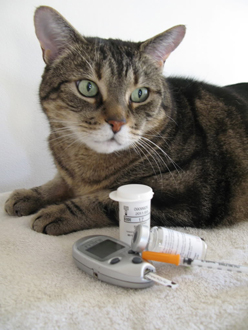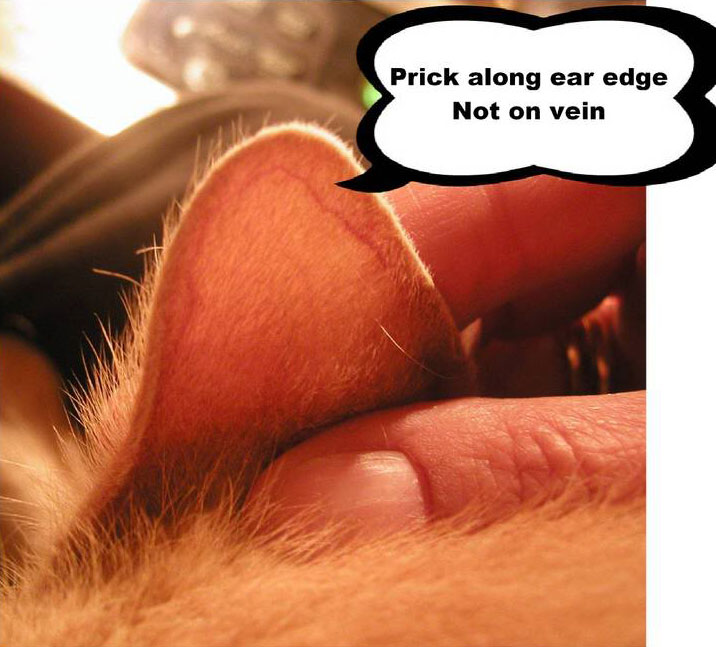Insulin and Testing
Right after a species appropriate low carb wet diet; the next most valuable weapons in your arsenal to fight feline diabetes are a glucometer, test strips, syringes and the right insulin for your cat.
 Prior to making ANY dietary changes, or starting Diabetic Cat Care’s Tight Regulation Protocol (TR), it is important that you understand simply removing dry kibble from the diet of a cat already receiving insulin can be very dangerous! For your cat’s safety, we request you join the forum to access critical information about the Detox Process. Experienced members will be able to answer any questions you have and guide you step-by-step through the Detox Process particular to your cat’s individual situation, making sure your cat is safe from clinical hypo and the transition onto TR is as smooth as possible. The sooner your cat starts TR after diagnosis, the better chance there is of achieving diabetic remission (or as we call it, going OTJ – Off the Juice).
Prior to making ANY dietary changes, or starting Diabetic Cat Care’s Tight Regulation Protocol (TR), it is important that you understand simply removing dry kibble from the diet of a cat already receiving insulin can be very dangerous! For your cat’s safety, we request you join the forum to access critical information about the Detox Process. Experienced members will be able to answer any questions you have and guide you step-by-step through the Detox Process particular to your cat’s individual situation, making sure your cat is safe from clinical hypo and the transition onto TR is as smooth as possible. The sooner your cat starts TR after diagnosis, the better chance there is of achieving diabetic remission (or as we call it, going OTJ – Off the Juice).
Blood Glucose (BG) Testing
Whether your vet supports blood testing or not, testing your cat’s blood sugar with a glucometer is imperative for the welfare of your cat and an absolute requirement for practicing TR. Any human glucometer will do – there is no need to spend triple the amount buying a “pet” glucometer sold exclusively at vet clinics. Most pet meters are simply repackaged human meters. The key to whatever meter you buy is to use the same meter all the time. You will want to get a glucometer that takes the least amount of blood and requires the least expensive test strips.
By testing your cat’s blood glucose, you will know when and if your cat needs insulin, what amount of insulin to give and even when to give it. Please see Protocol for more information.
It is very easy to test a cat’s BG, although it can be intimidating to some at the start. Take a flashlight, or sit your cat between you and a light source and you will see the very small vein that runs around the outer edge of the ear. It is between the vein and the outer edge of the ear where the blood tests are performed using a lancet pen.
Most cats take to testing very quickly, particularly once they associate the testing with making them feel better. Please watch this![]() clip explaining how to test your cat’s blood sugar levels at home. Positive reinforcement such as a low carb treat right after testing really helps to ensure successful results.
clip explaining how to test your cat’s blood sugar levels at home. Positive reinforcement such as a low carb treat right after testing really helps to ensure successful results.
 While you may think you are hurting your cat, nothing could be further from the truth! Our cats have very few nerve endings in their ears – testing is more of an annoyance to them, like a mosquito buzzing around their ear. After only a few blood tests, most of us find that our cats actually start to purr knowing that you are working to make them feel better, creating a much deeper bond. Every member at Diabetic Cat Care has gone through the process of moving past our angst about testing our cat’s BG. After joining the forum, please read through DCC’s TR College of Knowledge, which includes detailed information about testing blood sugar. Knowledgeable members at DCC will readily provide you with lots of support as well as many tricks and tips to make blood glucose testing very easy for you and your cat.
While you may think you are hurting your cat, nothing could be further from the truth! Our cats have very few nerve endings in their ears – testing is more of an annoyance to them, like a mosquito buzzing around their ear. After only a few blood tests, most of us find that our cats actually start to purr knowing that you are working to make them feel better, creating a much deeper bond. Every member at Diabetic Cat Care has gone through the process of moving past our angst about testing our cat’s BG. After joining the forum, please read through DCC’s TR College of Knowledge, which includes detailed information about testing blood sugar. Knowledgeable members at DCC will readily provide you with lots of support as well as many tricks and tips to make blood glucose testing very easy for you and your cat.
Syringes
There are many types of syringes available and depending on your location, a prescription could be required – please join the forum for further information about global insulin and syringe laws. We recommend purchasing 3/10cc syringes for 30 units of insulin or less, with half unit markings which come with both short and long needles and are made for use with U100 strength insulin. While you may be using U40 strength insulin, with a simple conversion, using U100 syringes will enable you consistent and far more accurate measuring of precise and/or very small doses of insulin for your cat. On the forum, experienced members of Diabetic Cat Care can help you source the proper syringes and learn how to use the U40 to U100 conversion chart if need be.
Selecting the Correct Insulin
Bovine based Protamine Zinc Insulin (PZI) is Dr. Hodgkins’ preferred choice when it comes to felines because it is gentle, predictable and is the closest to a cat’s own insulin structure. However, bovine based PZI is not available everywhere. There are different types and strengths of PZI available –bovine, salmon or hrDNA based. Commonly used compounded PZI from the US typically has duration of approximately 8 hours in cats (as does US manufactured ProZinc which is salmon/hrDNA based). Hypurin Bovine PZI has extended duration properties lasting up to 18 hours in cats. Hypurin iis manufactured in the UK but available to import to other countries. PZI is either manufactured (consistent from batch to batch), or compounded (much less consistency from batch to batch, more potential for contamination). Each type of PZI has its own characteristics and nuances when it comes to how they work.
Other types of insulin which have proven over time to work very well with TR (Tight Regulation) are:
Levemir (aka Detemir) is relatively new when it comes to being used in felines; it is synthetic human insulin with a neutral PH, and has a gentle and predictable or “peak less” curve. It is flexible to work with and some cats which have been difficult to regulate on other insulin types can become better regulated when switched to Levemir.
Lantus (aka Glargine) can also be used successfully for TR. Lantus is insulin that requires patience because of its crystalized depot properties and typically requires dosing changes to be made in small increments because of its slow release action.
Caninsulin (aka Vetsulin) was originally created for dogs and is the first insulin vets will prescribe for diabetic cats in Europe. Cats generally seem to be responding better to Caninsulin than before, particularly when first diagnosed due to changes in its formula. Caninsulin is medium acting insulin, dropping the BG relatively quickly with a shorter lived nadir (when the insulin is most potent/lowest BG on the shot). For some cats, it can leave the system quickly allowing the BG to rise rapidly.
NPH is another insulin type commonly prescribed for cats and fits the medium-duration category; also typically dropping the BG quickly and with a short lived nadir. NPH usually leaves the system very rapidly which can be like a rollercoaster ride for some cats.
We invite you to join our Diabetic Cat Care Forum to gain access to specific details and dosing scales for all insulin types mentioned above as well as details about starting TR safely.
